Transforming a teenager’s bedroom into a personalized sanctuary has become a popular trend, and it’s easy to see why! These spaces are more than just places to sleep—they’re a reflection of personality, creativity, and growth. With endless possibilities, teens and parents alike are eager to discover design ideas that inspire confidence, comfort, and self-expression.
In this article, you’ll find a diverse range of bedroom ideas that blend style with functionality, from bold color schemes to cozy nook corners and inspiring wall art. Whether you’re aiming for a trendy, minimalist, or eclectic vibe, these ideas will help you craft a space that supports personal growth and makes everyday living more enjoyable. Get ready to transform any teen bedroom into a motivational and stylish retreat!
1. Create a Calm Meditation Corner with Soft Lighting and Cozy Cushions
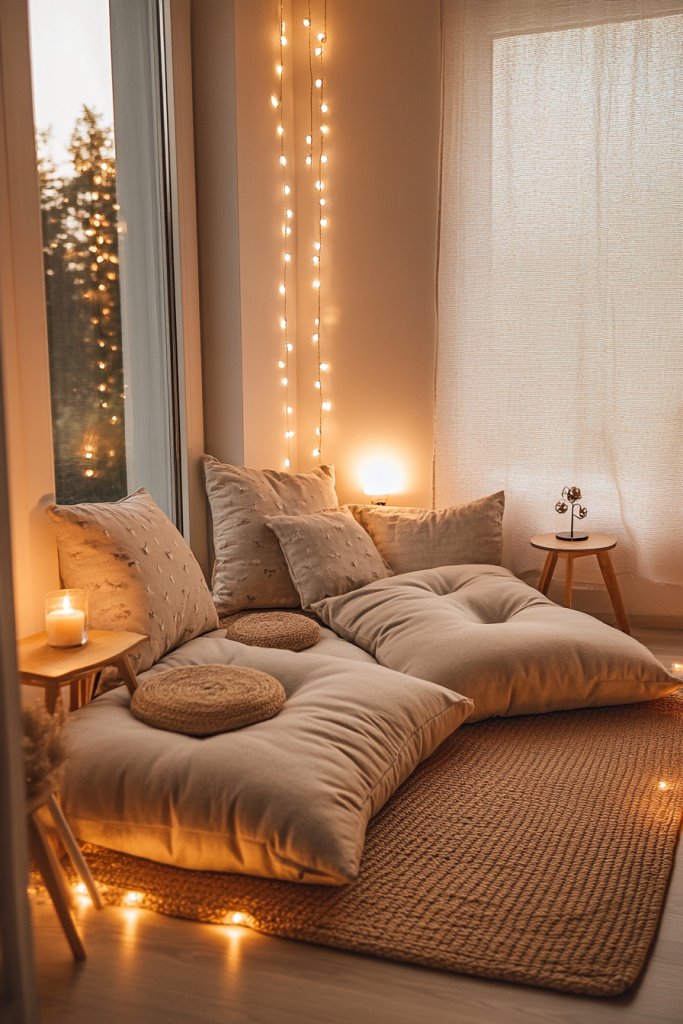
Teenagers often feel overwhelmed by school, social pressures, and personal growth challenges. Finding a peaceful space to unwind and reflect can seem impossible in a small or cluttered room. Creating a dedicated meditation corner offers a simple escape to reset mentally and emotionally. It’s about giving yourself permission to pause and breathe amid chaos.
Picture a cozy nook tucked in a quiet corner, featuring plush cushions in calming shades like soft blues or gentle greys. Dim, warm lighting creates a soothing atmosphere, while textured throws and a soft cream throw blanket add inviting comfort. The space might include a small, textured rug beneath the cushions, with gentle sounds of calming music or nature filling the air. It’s a perfect retreat for mindfulness or just a moment of peace.
Adjust the cushions and lighting based on personal style—boho, minimalist, or cozy cottage. For colder seasons, add a faux fur throw or layered textured blankets; for summer, opt for breathable cushions and airy fabrics. If space is limited, consider a foldable floor cushion or a small portable mat. The key is flexibility to match your vibe and room size.
Start by selecting a quiet corner away from distractions. Use soft cushions or floor pillows in soothing textures. Install soft, adjustable lighting like dimmable lamps or fairy lights (avoiding actual pendant lights or table lamps if restricted). Add calming decor such as textured throws and a plush rug. Keep the area clutter-free, with maybe a small shelf for meditation guides or calming crystals, avoiding restricted decor items. Maintain the space regularly for peace of mind.
Personalize with meaningful items—favorite books, calming scents in diffusers (no wall art or artwork), or a small sculpture that inspires tranquility. Incorporate sensory elements like a textured wall hanging or a soft fabric backdrop to deepen the calming effect. Use different cushion covers seasonally or for mood shifts. The goal is to make this space truly your own sanctuary.
Having a dedicated meditation corner encourages daily mindfulness, boosting emotional resilience. It signals to yourself that your mental health matters. With consistent use, it can become a vital part of your routine, helping you face life’s challenges with calm and confidence. Remember, this space is your personal retreat—embrace it and make it your own.
2. Incorporate Inspirational Quote Wall Decals for Daily Motivation
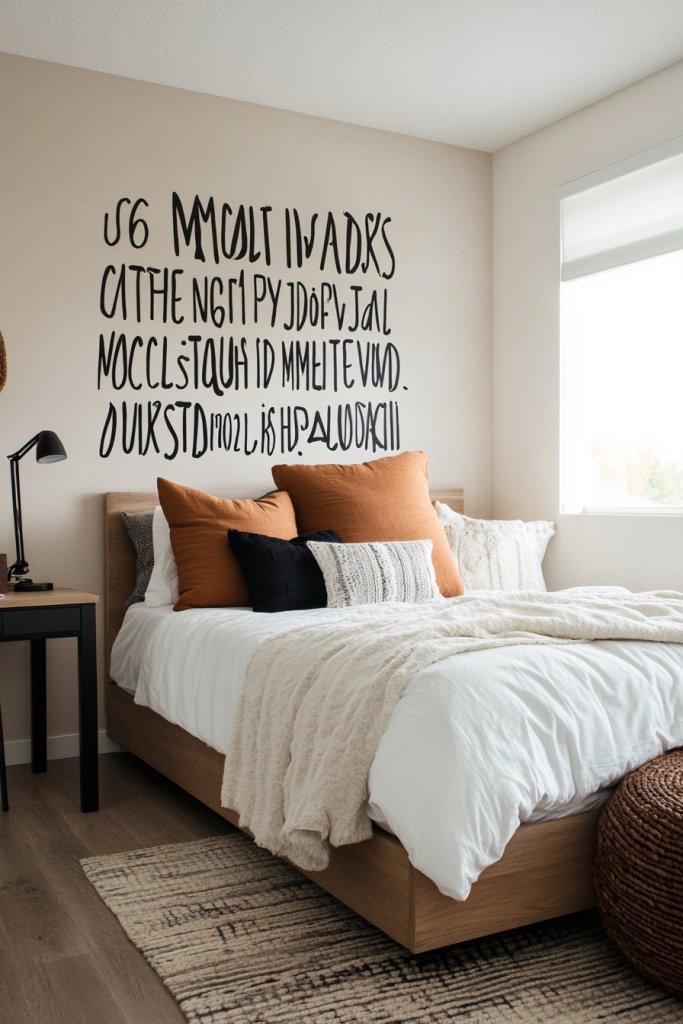
Getting through teenage years can feel like an emotional rollercoaster. Sometimes, you need a little boost to keep going when motivation wanes. Inspirational quotes are a quick, effective way to remind yourself of your strength and potential. But wall decals? They make that motivation visible and permanent, so you see it daily.
Imagine bold, removable decals with uplifting quotes like ‘Believe in Yourself’ or ‘Dream Big’ splashed across a wall in vibrant colors. They sit atop neutral or pastel backgrounds, creating a striking contrast that draws your eye. The fonts range from handwritten scripts to modern sans-serif, making the quotes feel personal and stylish. The decals can be placed above your desk, bed, or closet, serving as constant reminders of your goals.
Choose decals that match your room’s aesthetic—minimalist, boho, or eclectic. For a more subtle look, opt for small decals near your mirror or beside your study area. If you like a pop of color, go for bright, contrasting shades. Seasonal or mood changes can be reflected by swapping out decals or adding new quotes. This customization keeps your space fresh and inspiring.
Start by selecting high-quality, removable decals that won’t damage walls. Clean the surface thoroughly before application. Position the decals at eye level for maximum impact. Use a ruler or level for straight lines if needed. Arrange multiple quotes creatively—perhaps in a vertical line or clustered for visual interest. Avoid cluttering the wall with too many decals; simplicity enhances their effect. Regularly update or add new decals to keep motivation fresh.
Personalize further by choosing quotes that resonate deeply with you—maybe lyrics, affirmations, or personal mantras. Combine decals with framed photos or handwritten notes to add layers of inspiration. Create a small, dedicated quote wall or incorporate decals into a larger gallery wall with other decorative elements (avoiding artwork). Use different font styles or colors to emphasize key words.
Seeing motivational quotes every day builds resilience and positivity. They serve as tiny pep talks whenever you need a boost. Over time, these words can shape your mindset, helping you stay focused on your goals and self-improvement. Remember, your space should reflect your inner strength—let these decals remind you of that every day.
3. Design a Minimalist Study Zone with Functional Shelving and Desk Space
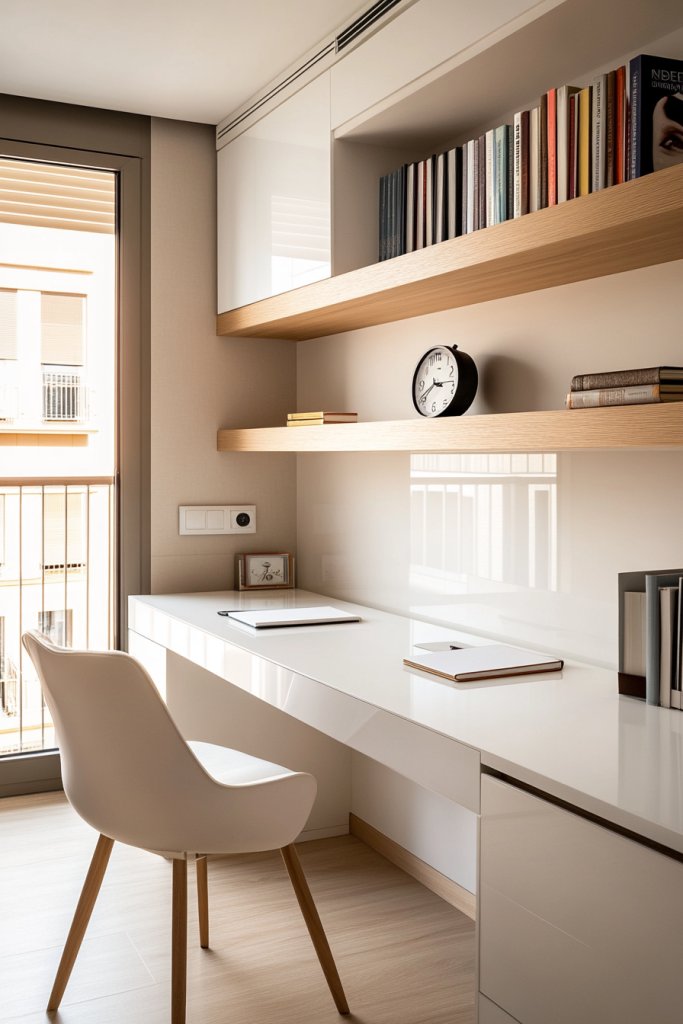
Teenagers often struggle with distractions when it’s time to study. A cluttered or chaotic workspace makes focusing nearly impossible. Creating a minimalist study zone helps clear mental clutter and sets a dedicated area for productivity. It’s about making study time efficient and stress-free, not a chore.
Imagine a sleek, clean desk in a neutral tone, with a slim, wall-mounted shelf above it holding only essential supplies—pens, notebooks, maybe a small organizer. The desk surface is free from clutter, with only a minimalist lamp and a notebook for quick notes. The background features a soft-colored wall and a textured wall panel for subtle visual interest. The entire setup feels calm and inviting, encouraging focus without overwhelming your senses.
For a more vibrant vibe, incorporate colorful accessories like a bright desk pad or a fun chair cover. If space is tight, opt for a fold-down desk or wall-mounted table. In a shared room, consider a partition or a curtain for privacy. During exam seasons, add a whiteboard or corkboard (avoiding wall art) for planning and reminders. Adapt the shelving style to match your room’s aesthetic—industrial, Scandinavian, or modern.
Start with a sturdy, simple desk that fits your space—preferably with built-in storage. Install floating shelves or wall-mounted organizers above for easy access to supplies. Keep the desktop clear by storing items in drawers or containers that fit under or on the shelves. Use adjustable lighting, such as clip-on lamps, to avoid bulky table lamps. Regularly declutter and organize to maintain the minimalist look. Avoid overdecorating to keep focus front and center.
Add personal touches like a favorite quote or a small decorative item that doesn’t distract. Use color-coded storage bins or labels for organization. Incorporate textured textiles, like a soft cushion on your chair, to make the space more comfortable. Change accessories seasonally or as your needs evolve—think new shelf liners or small decorative elements.
A well-designed study zone boosts your confidence in tackling schoolwork. It’s a space that signals seriousness and respect for your education. With an organized environment, you’ll find it easier to stay motivated and disciplined. Remember, a simple, clutter-free workspace can make a big difference in your academic performance.
4. Add a Personal Vision Board with Motivational Images and Goals
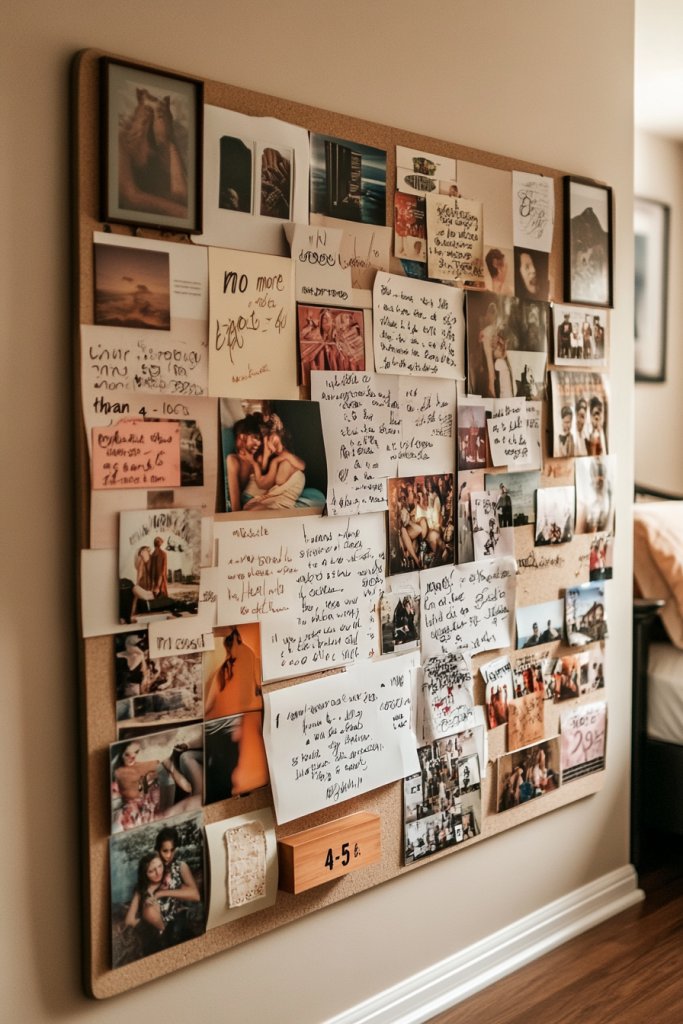
Teenagers often have big dreams but struggle to keep their goals front and center. Without a visual reminder, it’s easy to forget aspirations amid daily distractions. A personal vision board keeps your ambitions in sight and fuels your motivation. It’s about turning dreams into actionable visual cues that inspire daily progress.
Picture a corkboard or poster board filled with cutouts from magazines—dream destinations, future career images, or inspiring quotes. Pin your short-term goals and long-term ambitions alongside photos of loved ones or favorite symbols. Surround these with colorful washi tapes or decorative borders to make the board lively. Hang it at eye level in your room where it’s impossible to ignore—above your desk or near your bed.
Use different boards for various themes—academic, personal growth, or hobbies. Change out images seasonally to reflect evolving goals or interests. For a more artistic vibe, create a collage on a canvas or large poster with layered textures and drawings (avoiding framed artwork). Incorporate motivational quotes or affirmations directly on the board for extra impact. Make it interactive by adding space for notes or progress updates.
Choose a sturdy board or canvas that fits your space. Gather magazines, printed images, and motivational quotes. Use push pins, clips, or washi tape to attach items—avoid permanent solutions that damage walls. Arrange items thoughtfully, balancing colors and themes for visual harmony. Regularly update the board as goals are achieved or new dreams emerge. Keep it accessible for daily inspiration.
Add personal mementos like small souvenirs or handwritten notes to deepen your connection. Use different textures—fabric patches, stickers, or decorative paper—to add depth. Incorporate a small calendar or planner nearby for tracking milestones. Keep the board dynamic—change images or add new elements weekly to stay motivated.
A personal vision board transforms abstract dreams into tangible visual goals, making them more attainable. It keeps your ambitions alive and reminds you of your potential. Over time, it becomes a source of daily encouragement, helping you stay committed. Remember, visual cues are powerful tools for personal growth—use them to your advantage.
5. Use Adjustable Lighting to Set the Mood for Relaxation and Concentration
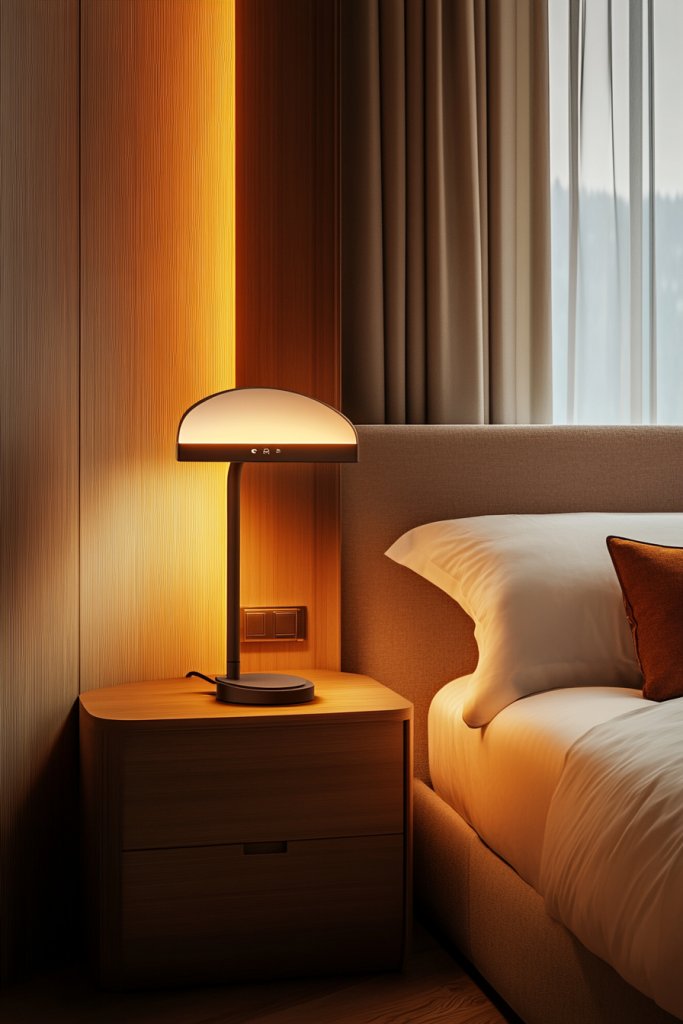
Teenagers often find it hard to switch between relaxing and focusing modes in their rooms. Harsh lighting can make studying stressful, while dim lighting might hinder relaxation. Adjustable lighting offers a flexible solution, letting you tailor your environment to your mood and activity. It’s about creating the perfect vibe whenever you need it.
Imagine a sleek desk lamp with touch controls or smart bulbs that change color and brightness. During study time, bright white light energizes your brain, while in the evening, soft amber tones create a cozy atmosphere. The lighting setup is clean and minimal, perhaps with a wall-mounted dimmer or remote control for convenience. The room glows softly, adapting effortlessly from focus to chill mode.
Choose lighting options that match your aesthetic—sleek modern LEDs, vintage Edison bulbs, or subtle sconces. For a small room, wall-mounted fixtures save space and reduce clutter. During different seasons, dimming options help adjust to natural light changes. Use smart bulbs compatible with voice or app control for ultimate convenience. These setups can be integrated into any room style—industrial, Scandinavian, or eclectic.
Start by selecting dimmable, energy-efficient bulbs or smart lighting kits. Install fixtures in key areas—above your desk, bed, or reading nook—avoiding overly decorative pendant lights if restricted. Use remote controls or apps for easy adjustments. Incorporate timers or voice commands to automate lighting changes. Regularly update your lighting settings for different activities—study, relaxation, or sleep. Keep the system simple for easy use.
Customize with colored bulbs or light strips to match your mood or season. Use warm tones for relaxation, cooler whites for focus. Add dimmer switches or voice control for effortless adjustments. Incorporate scented candles or diffusers nearby (not as primary lighting) to enhance ambiance. Personal touches make the space more inviting and adaptable.
Smart, adjustable lighting transforms your space into a flexible retreat that supports your mental well-being. It empowers you to control your environment easily, fostering independence and confidence. With the right lighting, you’ll find it easier to focus on work or unwind after a long day. Small changes in your room’s lighting can make a big difference in your mood and productivity.
6. Implement a Color Palette that Promotes Calm and Focus
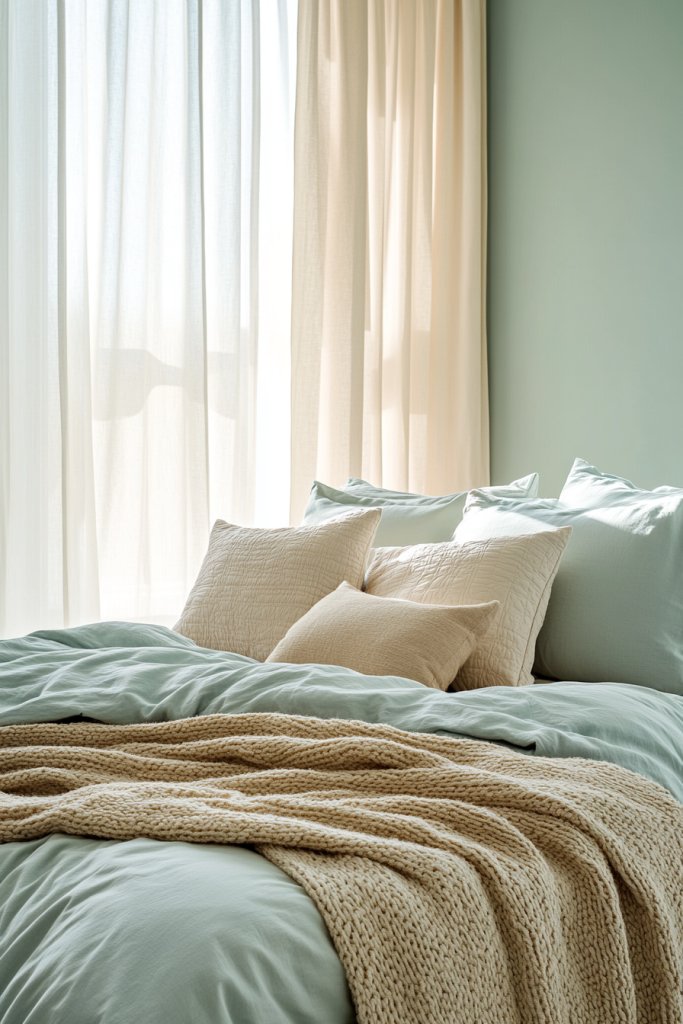
Teenagers are easily distracted, and a chaotic color scheme can add to that confusion. Choosing a calming palette helps create a serene environment conducive to studying and relaxation. It’s about setting a visual tone that encourages focus and peace. Your room’s colors should work with your mood, not against it.
Envision a tranquil room painted in soft pastels—light blue, mint green, or warm beige. These colors reflect natural light, making the space feel bigger and more peaceful. Textured textiles, like linen curtains or woven throws, complement the soothing palette without adding visual noise. The overall look is minimal yet inviting, with subtle color accents in accessories or decor.
Adjust the palette to match your personality—cool tones for a modern vibe, earth tones for a cozy feel, or monochrome for a sleek look. Seasonal accents, like warm oranges or deep reds in fall, can add variety without disrupting the calming base. Use accent walls or furniture in contrasting but harmonious shades for visual interest. Keep accessories simple to avoid cluttering the restful atmosphere.
Select paint colors or wallpaper in soft shades that promote calm. Keep furniture in neutral tones—light wood, soft grey, or white—and add pops of color through textiles like cushions or throws (avoiding excessive decor). Use natural, textured materials like cotton or linen for curtains and bedding. Balance color with natural light to enhance the room’s tranquility. Regularly review and adjust to maintain the calming effect.
Incorporate your favorite subtle accent colors—perhaps a soft blush or muted terracotta—through accessories or textiles. Layer different textures, such as a plush rug or a chunky knit throw, for depth. Use decorative storage in matching shades to keep clutter out of sight. Seasonal color swaps can refresh the space without major changes.
A well-chosen color palette sets the tone for a balanced, harmonious life. It helps you stay calm, centered, and ready to face challenges. When your space feels peaceful, your mind can focus better and feel more confident. Remember, colors influence mood—use them wisely to support your growth.
7. Incorporate Functional Storage Solutions to Reduce Clutter
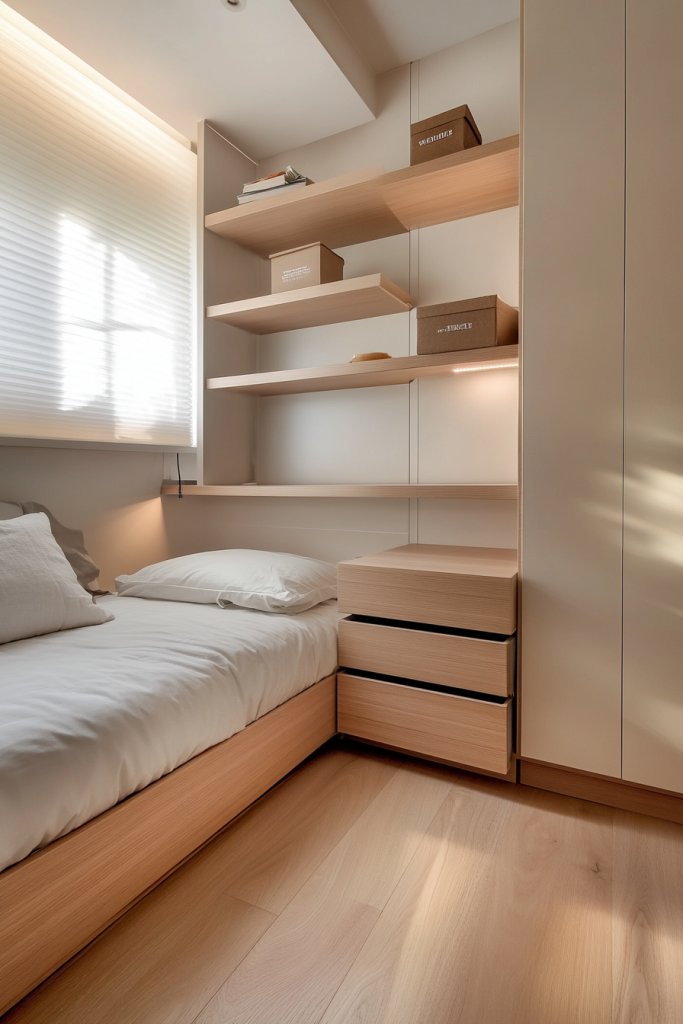
Cluttered rooms drain energy and make it hard to focus. Teenagers often struggle with organizing their belongings in small spaces. Functional storage solutions help keep essentials accessible while maintaining a tidy look. When everything has a place, your room feels calmer and more inviting.
Imagine under-bed drawers neatly filled with seasonal clothes or sports gear. Wall-mounted shelves hold books, accessories, or organizing bins, all in sleek materials that match your style. Multi-purpose furniture, like a storage ottoman or a bed with drawers, hides clutter effortlessly. The overall effect is a streamlined, organized space that invites relaxation and productivity.
Choose storage options that suit your aesthetic—industrial metal, minimalist wood, or colorful bins for a playful vibe. For small rooms, vertical storage is key; for larger rooms, add decorative baskets or chests. Modular units allow flexibility and growth. Seasonal or themed storage can be swapped out easily, keeping your room fresh and organized.
Start with assessing your storage needs—clothes, supplies, personal items. Invest in multi-functional furniture like beds with built-in drawers or fold-away desks. Use wall-mounted shelves or pegboards to maximize vertical space, avoiding bulky bookcases. Label containers for quick access and consistency. Regularly declutter to prevent accumulation of unused items. Keep a routine for tidying to sustain order.
Decorate storage units with colorful or textured baskets that match your room’s theme. Use clear containers for visibility or fabric bins for softness. Incorporate personalized labels or tags for easy identification. Add small decorative touches like a patterned box or a stylish storage bench at the foot of your bed. Keep your storage both functional and reflective of your personality.
An organized space boosts your confidence and makes daily routines smoother. It teaches responsibility and discipline, skills that will serve you well beyond teen years. When clutter no longer dominates your room, you gain mental clarity and energy. A neat environment is a foundation for personal growth and success.
8. Design a Creative Corner with Art Supplies and Inspiration Boards
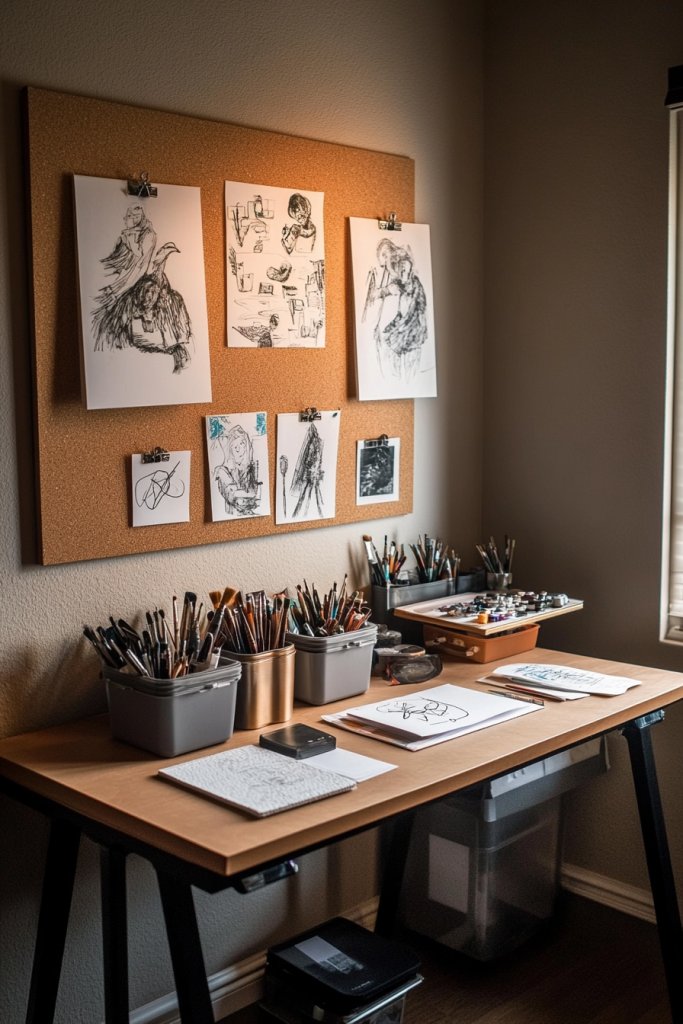
Teenagers with artistic inclinations or hobbies need a dedicated space to unleash creativity. Without a proper area, art supplies clutter the room or stay hidden, limiting inspiration. Establishing a creative corner encourages regular practice and self-expression. It’s about making art an accessible, enjoyable part of daily life.
Visualize a compact desk or table with organized compartments for markers, paints, and sketchbooks—preferably in a corner with natural light or a flexible lamp. Nearby, a corkboard or fabric-covered pinboard displays sketches, ideas, or inspirational images. Shelves hold art tools, while colorful containers keep supplies tidy. The space feels lively and motivating, inviting spontaneous bursts of creativity.
For small rooms, choose fold-away tables or wall-mounted boards to save space. Use colorful storage bins or fabric organizers for supplies, matching your style—boho, modern, or eclectic. Seasonal projects can be stored in stackable boxes, ready for when inspiration strikes. Personalize with your favorite color schemes or thematic decor to inspire ongoing projects.
Select a sturdy table or desk with ample surface area. Install a pinboard or corkboard for displaying ideas—make sure it’s at eye level. Use transparent containers, baskets, or drawer units for organizing supplies, avoiding clutter. Add a comfortable chair or stool that fits your height. Keep the area clean and stocked for spontaneous creativity, regularly decluttering messy supplies. Incorporate a small set of tools or reference materials nearby.
Decorate the space with your favorite colors or patterns—think fabric covers or wall decals (avoiding wall art). Incorporate a small lamp or clip-on light for extra brightness. Personalize with your favorite inspirational quotes or doodles on the wall. Adjust storage containers seasonally or as your projects evolve, keeping the space fresh and engaging.
A dedicated creative corner nurtures your artistic talents and boosts confidence in your skills. It signals that your passions are valued and worth investing time in. With a consistent space for art, you’ll develop discipline and see your progress over time. Remember, every masterpiece starts with a dedicated spot and a little inspiration.
9. Install a Compact Reading Nook with Comfortable Seating and Good Lighting
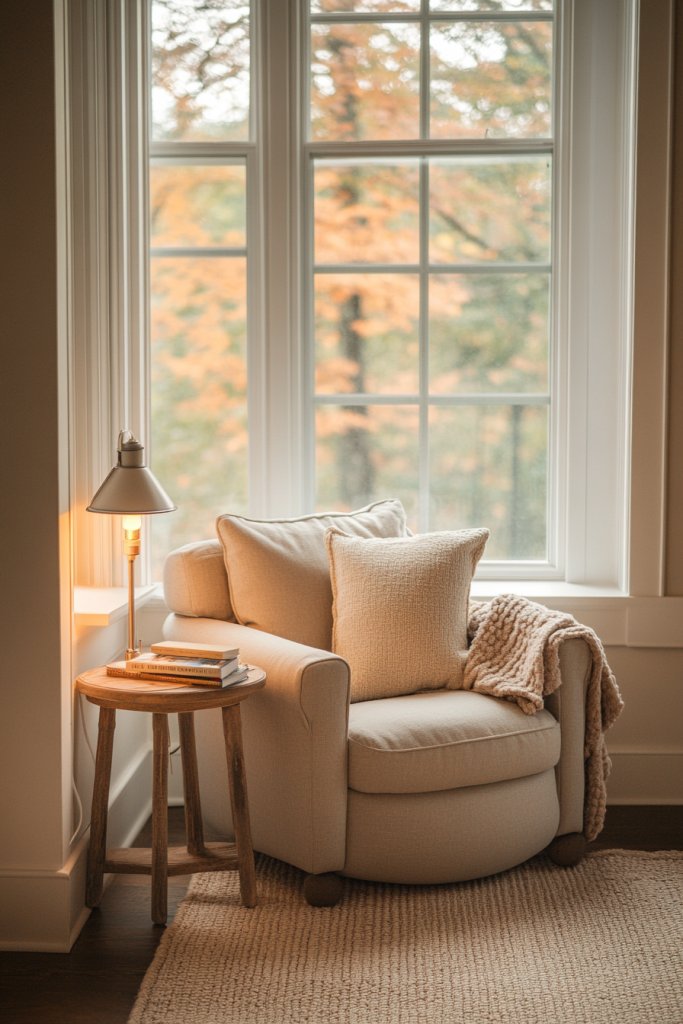
Teenagers love to escape into stories, but a cramped or uncomfortable space can ruin the experience. Without a cozy reading nook, reading feels like a chore rather than a pleasure. Creating a dedicated spot for books makes reading inviting and helps foster a lifelong love of literature. It’s about making your room an oasis of calm for reading and reflection.
Envision a small corner featuring a plush lounge chair or a soft bean bag, topped with a cozy throw pillow or blanket. Good lighting is essential—perhaps a clip-on reading light or a small, adjustable lamp. Shelving nearby holds your favorite books, with a textured rug underneath adding warmth. The space feels intimate and inviting, encouraging long reading sessions without distractions.
If space is tight, opt for a window seat with built-in storage or a corner with a small cushion and a side table. For a more vibrant look, incorporate colorful textiles and patterned fabrics. During different seasons, add layers like a soft fleece blanket or a decorative pillow. In shared rooms, use portable or foldable furniture that can be moved easily. Personalize with your favorite colors or themes.
Choose a comfortable chair or cushion that supports good posture. Install a focused light source—LED clip-on lamps work well—avoiding large lamps that take up space. Place bookshelves or wall-mounted racks within reach. Add a textured rug or mat to define the nook. Keep the area tidy with nearby baskets or small storage containers for accessories. Regularly rotate your reading material to keep the space fresh.
Add decorative elements like a soft throw blanket, personalized bookplates, or themed cushions. Incorporate a small side table for drinks or snacks. Use a fabric or textured wall panel behind the seating for a cozy vibe (avoiding wall art). Change out textiles seasonally to match your mood or decor updates. Make the nook a reflection of your reading tastes.
A dedicated reading space makes getting lost in a story a daily habit and nurtures your imagination. It helps you unwind and reduces stress, fostering emotional well-being. Over time, this space becomes a personal sanctuary, boosting your confidence in your tastes and interests. Remember, a good book and a comfy spot can change your entire day.
10. Incorporate Personal Growth Bookshelves with Motivational Titles
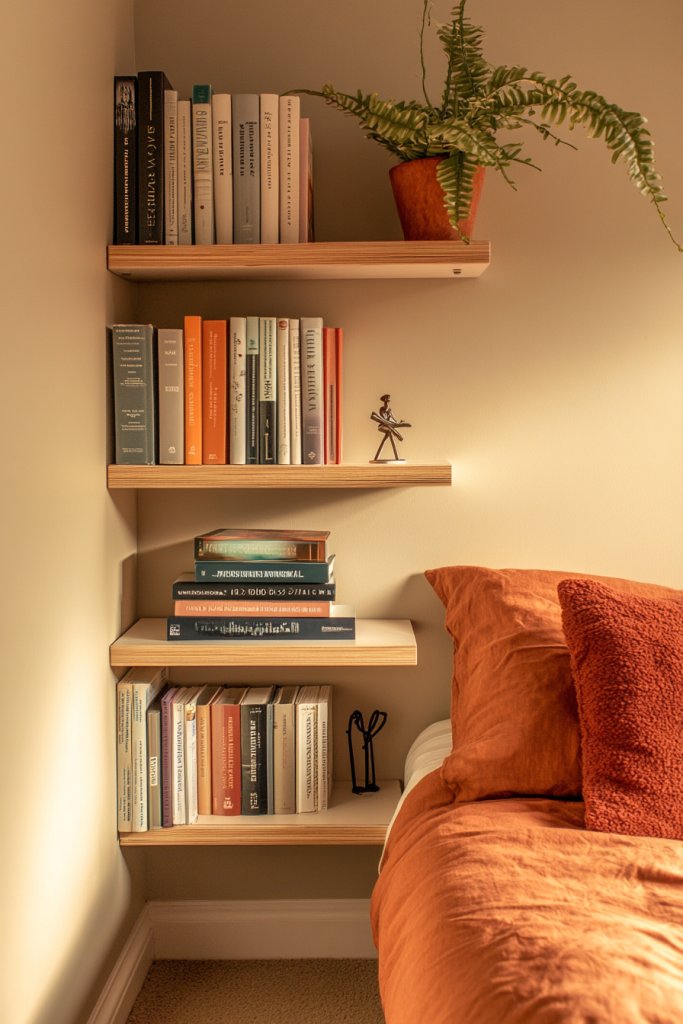
Teenagers eager to grow and learn often have a collection of self-help or motivational books, but these tend to stay hidden or disorganized. A dedicated bookshelf for personal development makes these resources easily accessible and encourages continuous self-improvement. It’s about turning your room into a hub of inspiration and knowledge.
Imagine a sleek wall-mounted shelf or a small freestanding unit filled with books on mindfulness, goal-setting, and success. The books are arranged neatly, with some standing upright and others stacked for visual interest. The spines display bold titles that motivate just by looking at them. Surrounding the shelf, subtle decor like textured boxes or inspiring quotes (avoiding wall art) reinforce the theme of growth. The setup invites curiosity and action.
Choose a style that matches your room—modern with metal and glass, rustic with wood, or colorful with painted shelves. For limited space, use vertical shelving or corner units. Rotate books seasonally or as your interests shift, keeping the collection fresh. You can add small decorative objects or motivational cards without cluttering the space.
Select sturdy shelves that fit your space and hold your collection. Organize books by theme, color, or size for visual harmony. Keep frequently used books within arm’s reach and store others in bins or baskets. Use labels or tags for easy identification. Regularly declutter and donate books you no longer need. Make it a ritual to browse and pick a book every day.
Add personal touches like handwritten notes inside books or bookmarks that reflect your personality. Incorporate inspiring quotes or mini posters nearby that align with the book themes. Use decorative storage boxes or bins to hold journals, planners, or related accessories. Keep the setup dynamic—swap books or update the display to stay motivated.
Having a dedicated bookshelf for growth resources reinforces your commitment to self-improvement. It creates an environment where learning feels natural and accessible. Over time, these books inspire new habits and mindsets, boosting your confidence in your ability to evolve. Your room becomes a personal sanctuary of growth and possibility.
11. Add a Wall of Achievements and Personal Milestones

Teenagers often overlook their successes, focusing instead on what’s next or what’s lacking. A wall dedicated to achievements and milestones celebrates progress and builds pride. It transforms your room into a visual reminder of your growth, motivating you to keep pushing forward. Who doesn’t need a bit of positive reinforcement?
Picture a neatly arranged display of certificates, medals, or photos capturing special moments. Use clipboards, corkboards, or magnetic strips to hold these mementos in an organized way. Incorporate personal photos or quotes that symbolize your journey. The wall becomes a visual timeline of your accomplishments, inspiring confidence and pride every time you look at it.
Create a dedicated space on a blank wall or part of a larger gallery layout. Use frames, clips, or string with clothespins for a flexible display. Change or add items as new milestones occur—no need for permanent fixtures. Incorporate decorative elements like washi tape or patterned paper to enhance visual appeal. Keep it balanced and aligned for a clean, inspiring look.
Gather certificates, photos, or awards that are meaningful. Choose a wall in your room that is visible but doesn’t clutter the space. Use frames for formal awards or clips for more casual keepsakes. Arrange items in chronological order or by category for clarity. Regularly update the display to reflect new achievements. Maintain the area by cleaning and reorganizing as needed.
Add decorative elements like motivational quotes or themed borders. Personalize with small keepsakes or handcrafted items. Use color-coordinated frames or materials to match your room’s style. Incorporate a small chalkboard or whiteboard nearby for goals and upcoming milestones, avoiding wall art. Make it a fun project to celebrate your growth.
Seeing your progress visually reinforces your self-belief and resilience. It reminds you of what you’re capable of and motivates continued effort. Celebrating milestones boosts your confidence and encourages a growth mindset. Your achievements, big or small, deserve a space where they can be proudly displayed and remembered.
12. Use Natural Materials and Textures to Create a Grounding Environment
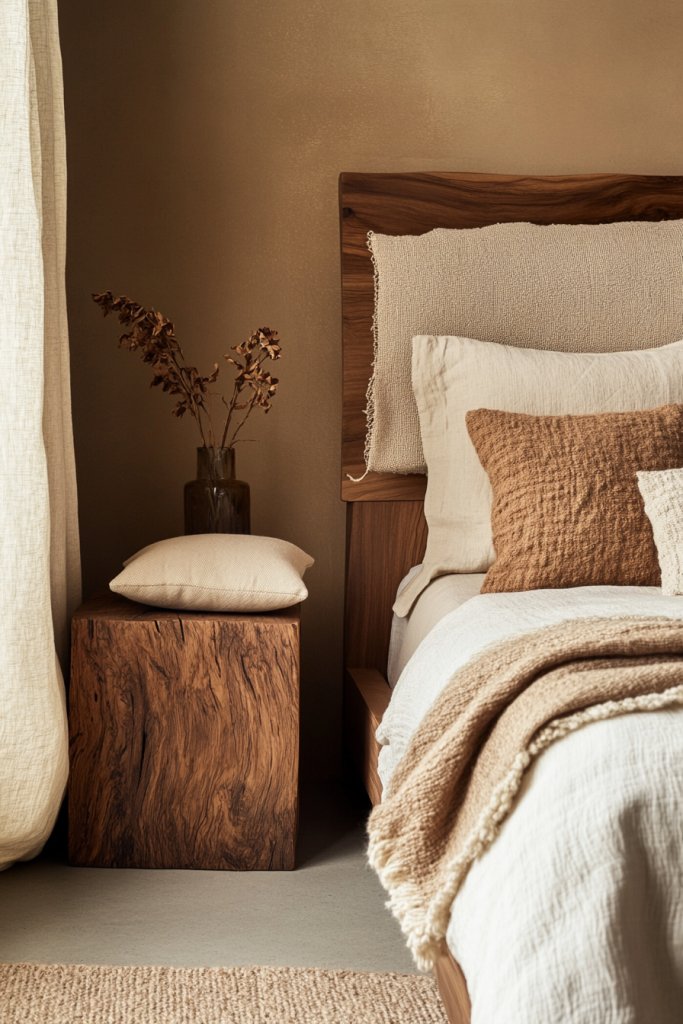
Teenagers often crave a peaceful space that feels rooted and calming. Synthetic or overly manufactured decor can make a room feel cold or disconnected. Using natural materials and varied textures creates a grounding environment that promotes serenity and mindfulness. It’s about making your space feel warm, inviting, and authentic.
Imagine a room with a textured linen or cotton bedding, woven jute rugs, and furniture made of light wood. Soft, tactile fabrics like wool or burlap add warmth, while neutral tones anchor the space. The combination of textures invites touch and comfort, creating a sensory-rich environment. Subtle details like a linen curtain or a woven basket enhance the organic feel, making your room a true retreat.
Mix and match materials—wood, jute, linen, and cotton—based on your preferences. For a cozy winter vibe, layer in chunky knit throws or tactile cushions. In warmer months, switch to lighter fabrics and woven accessories. Incorporate natural fiber-based storage or decorative accents to keep the look cohesive. Adapt the decor style to be rustic, Scandinavian, or boho—it’s all about your personal feel.
Start by choosing furniture with natural wood finishes or bamboo accents. Use textiles in earthy tones—beige, cream, soft greens—and combine different textures for visual interest. Add woven baskets for storage and textured throws or pillows for comfort. Incorporate natural fiber rugs and curtains that let in soft natural light. Avoid synthetic plastics or overly glossy surfaces to maintain the grounding vibe. Regular cleaning keeps textures inviting.
Add handcrafted items or DIY projects using natural materials—wooden wall art, woven wall hangings, or linen banners. Use neutral-colored storage containers for a seamless look. Incorporate subtle scent elements like cedar or lavender in sachets or diffusers (avoiding artificial scents). Seasonal swaps with different textures keep the space fresh and aligned with your mood.
Natural materials create a peaceful sanctuary that nurtures your well-being. It encourages mindfulness, reducing stress and anxiety. Over time, this grounding environment fosters confidence and emotional resilience. Your room becomes a reflection of your authentic self, supporting your journey toward personal growth.
13. Set Up a Digital Detox Zone with Distraction-Free Tech Areas
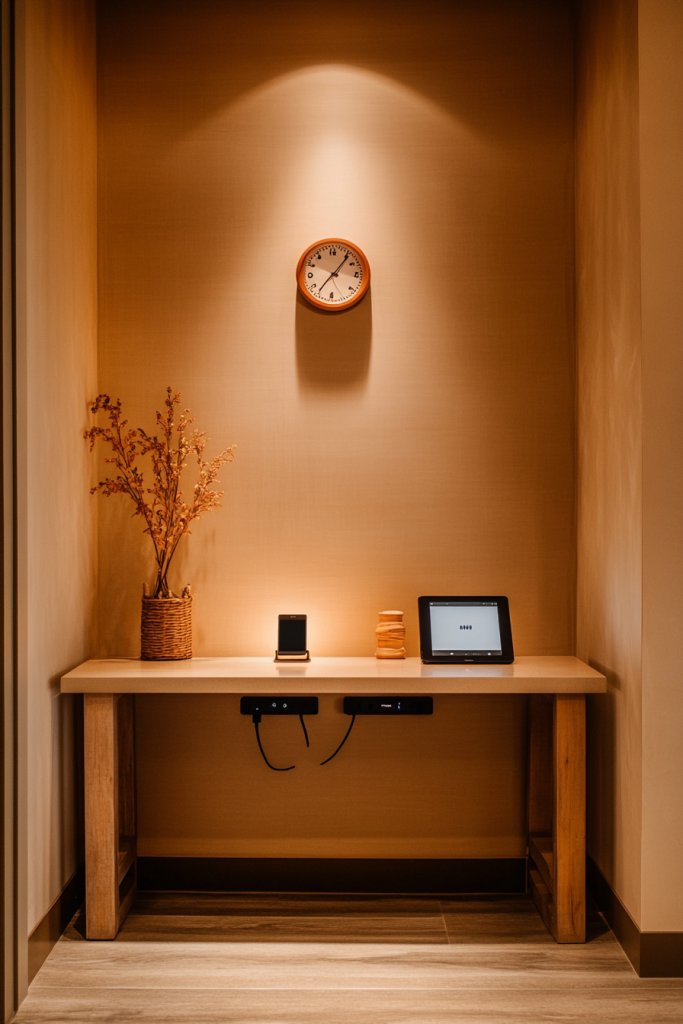
Teenagers are glued to screens, often sacrificing sleep, focus, and real social interactions. A dedicated digital detox zone encourages face-to-face connections and mindful tech use. It’s about creating a space where technology takes a backseat, so you can reconnect with yourself and others.
Imagine a cozy corner with a small table or bench devoid of screens—no laptops or phones in sight. Instead, it features books, journals, or creative supplies. Soft cushions or textured blankets invite you to sit and relax without digital distractions. The space might include a small chalkboard or whiteboard for planning or doodling, emphasizing offline activities.
Use a simple, clutter-free setup—just a small table with a few non-digital activities. Incorporate tactile objects like clay, sketchbooks, or puzzles to promote engagement. For shared rooms, create a designated corner away from beds or desks. Seasonal decorations or cozy textiles can make the space inviting. Use natural lighting to enhance the calming atmosphere.
Choose a small, dedicated area away from your main tech zones. Keep it free of electronic devices—no chargers or cords. Stock it with offline activities like journaling, reading, or crafts. Use a simple table or floor cushions to create a comfortable environment. Encourage regular use—perhaps during study breaks or wind-down times. Maintain the area by removing distractions and adding new activities.
Personalize with your favorite notebooks, art supplies, or tactile objects like stones or shells. Use decorative mats or textured fabrics to make the space cozy. Incorporate motivational quotes or mindfulness prompts (avoiding wall decor) to reinforce offline habits. Try adding a small portable activity kit you can take anywhere.
A digital detox zone helps you regain control over your time and attention. It boosts your ability to focus on real-world interactions and self-awareness. Over time, it fosters confidence in your ability to disconnect and reconnect meaningfully. Remember, sometimes stepping back from screens is the best way forward.
14. Create a Personal Growth Journal Corner with a Stylish Stationery Display
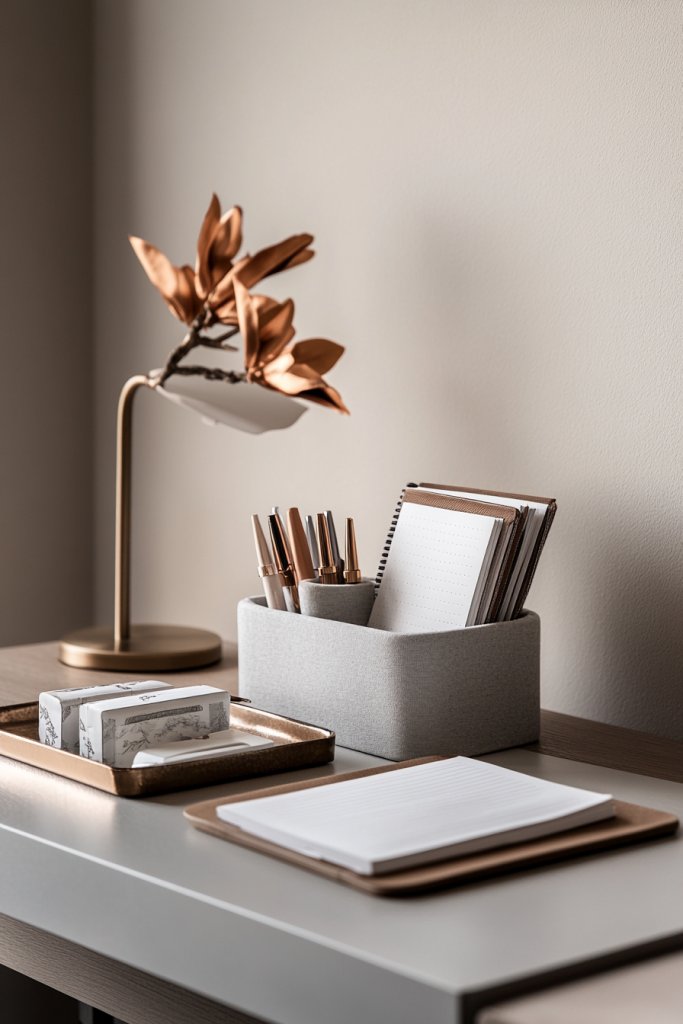
Teenagers often keep journals or planners but lack a dedicated, inspiring space to write. Without an organized corner, journaling can feel like a chore rather than a habit. Setting up a personal growth journal corner encourages reflection, goal setting, and self-awareness. It’s about making journaling a pleasurable, integral part of your routine.
Imagine a small desk or a cozy table with a stylish stationery display—pens, notebooks, stickers—all within reach. A neatly arranged collection of colorful pens, highlighters, and decorative notebooks makes the space inviting. Nearby, a small tray or organizer keeps supplies tidy, while a corkboard or magnetic strip displays inspiring quotes or goals. The setup feels personalized and motivating, inspiring daily reflection.
Choose a desk or table that fits your space—compact or multi-purpose. Use colorful or textured storage containers that match your aesthetic. Incorporate themed stationery sets—pastel, metallic, or minimalist—to keep the space lively. Seasonal or mood-based updates, like new stickers or cover designs, refresh the corner regularly. Keep it practical and inspiring, no matter your style.
Start with a small table or desk that holds your favorite journals and writing tools. Organize supplies in decorative containers or on a stylish tray. Attach a corkboard or a magnetic strip nearby for quick notes or visual goals—avoiding wall art to stay minimal. Make sure lighting is adequate—perhaps a small desk lamp. Cultivate the habit by keeping the space inviting and clutter-free. Regularly revisit and update your journals and display.
Personalize with stickers, washi tapes, or customized covers for your notebooks. Add motivational quotes on sticky notes or small cards. Incorporate your favorite colors or patterns in the stationery and containers. Use a decorative pinboard or a small shelf for inspirational items. Make it a fun, evolving space that reflects your growth journey.
A dedicated journal corner transforms reflection from a chore into a deliberate act of self-care. It encourages honesty, mindfulness, and goal tracking. Over time, it boosts your confidence as you see your progress and personal growth unfold. Your room becomes a sanctuary of self-discovery—powered by your words and ideas.
15. Install a Multi-Functional Bed with Built-In Storage and Study Space
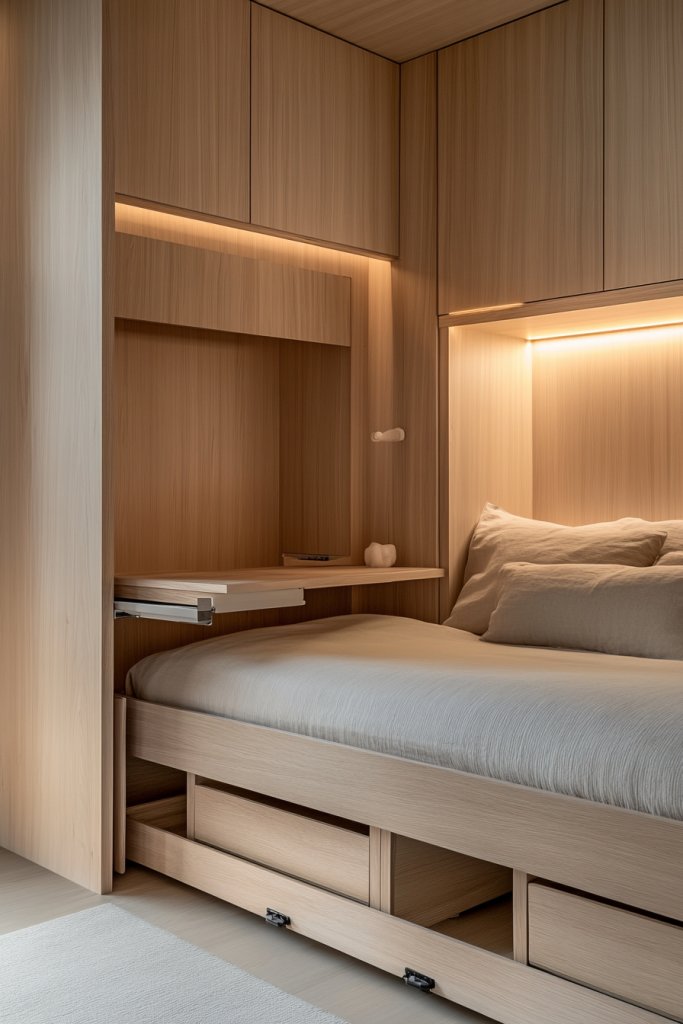
Teen rooms often lack space for both sleep and study, forcing clutter and chaos. A multi-functional bed with built-in storage and a study area solves this dilemma by combining essentials in one piece. It maximizes space and keeps your room organized, making it easier to relax and focus. It’s the ultimate space-saving upgrade.
Imagine a sleek platform bed with drawers underneath for clothes or accessories, paired with a small desk attached at the head or foot. The design is modern, with clean lines and neutral tones that blend seamlessly. The workspace includes a comfortable chair and a bright, focused light—without taking up extra space. The overall look is neat, efficient, and inviting, transforming your room into a cozy retreat that’s also functional.
Choose a bed with different storage options—drawers, shelves, or a fold-out desk. For smaller rooms, select a compact design that maximizes vertical space. In shared spaces, incorporate privacy screens or modular configurations. During different seasons, swap bedding or accessories to match your mood or decor. Personalize with color schemes and materials that suit your style—minimalist, industrial, or cozy.
Start by measuring your space and selecting a bed with integrated storage and study features. Assemble the bed following manufacturer instructions, ensuring stability. Arrange study essentials—notebooks, stationery, and a good chair—nearby. Use organizers within drawers or shelves to keep everything tidy. Position the bed for optimal natural light exposure. Regularly declutter and reorganize to maintain a clean, functional environment.
Add colorful or textured bedding to reflect your style. Incorporate small decor pieces like a soft cushion or a throw blanket to make the space inviting. Use decorative storage bins or labels for quick access. Change the setup seasonally—adding fairy lights or decorative pillows—to keep the space lively. Make it uniquely yours with personal touches that inspire comfort and productivity.
A multi-functional bed simplifies your space and boosts confidence in managing your environment. It encourages organization and responsibility, skills that will serve you well beyond teen years. When your room is tidy and efficient, your mindset shifts toward growth and success. It’s not just furniture; it’s a foundation for your personal development journey.
16. Incorporate a Tech-Free Zone with Noise-Canceling Headphones and Distraction-Free Area
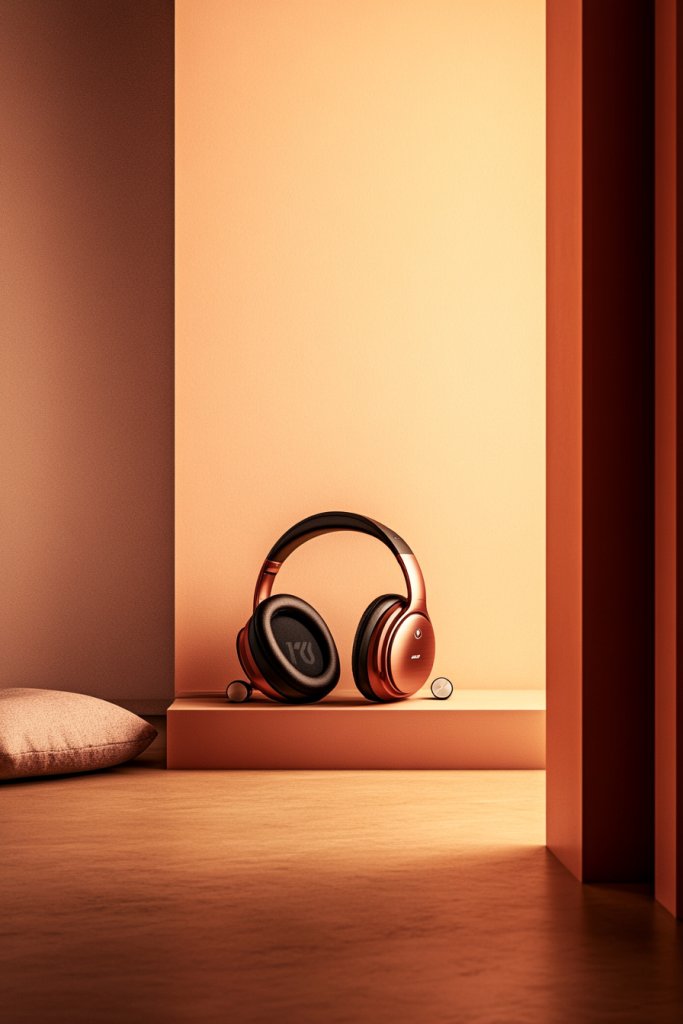
Teenagers often find it hard to disconnect from endless notifications and social media. Constant digital distractions hinder focus and mental peace. Creating a dedicated tech-free zone encourages mindful breaks and face-to-face interactions. It’s about reclaiming your mental space and fostering real-world connections.
Picture a cozy corner with a small table or a soft mat, free from electronic devices. Instead of screens, it features a journal, a book, or creative supplies—like sketchbooks or modeling clay. A comfortable cushion or a plush mat invites you to sit and relax without tech. Soft lighting and textured textiles create a warm, inviting environment that screams calm and focus.
Use a simple, designated area away from your main tech zones—perhaps near a window or quiet corner. Incorporate tactile objects like stress balls, puzzles, or art supplies to promote engagement. For shared rooms, use a portable or foldable setup that can be moved or stored easily. Seasonal accents like soft blankets or decorative pillows can make it more inviting. The key is simplicity and accessibility.
Choose a small space that can be dedicated to offline activities. Keep it free of electronic devices—no chargers or cords. Stock it with non-digital activities: books, journals, art supplies, or meditation tools. Use a small table, cushion, or a textured mat for comfort. Encourage regular use—perhaps during study breaks or before bed. Maintain the space by removing distractions and updating activities to keep it fresh.
Decorate with your favorite tactile objects—like a textured rug, cozy blanket, or personal art. Personalize with motivational quotes or mindfulness prompts (avoiding wall art). Use sensory elements like calming scents or textured fabrics to enhance the experience. Keep a small, portable activity kit for on-the-go mindfulness. Make it your go-to space for mental reset.
A dedicated tech-free zone strengthens your ability to focus and relax without digital noise. It teaches self-control and mindfulness, building resilience against distractions. Over time, you’ll develop healthier habits and better mental clarity. Your room becomes a sanctuary for growth, calm, and confidence—powered by your intentional choices.
17. Use Layered Textiles such as Rugs and Throw Blankets for Comfort and Style
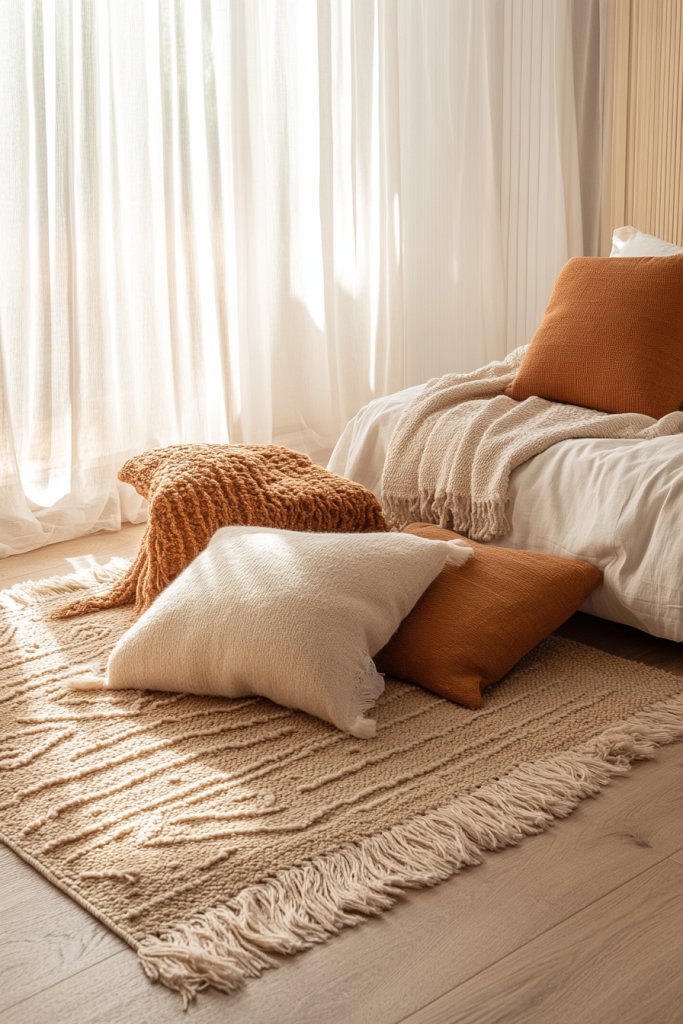
Teen rooms can feel cold or sterile without warmth and texture. Layered textiles instantly add coziness and personality to any space. They make your room inviting, encouraging you to relax or snuggle up with a good book. It’s about creating a tactile, stylish environment that feels like home.
Imagine a soft, plush rug under your bed or seating area, complemented by a chunky knit throw blanket draped over your chair or bed. Mix textures—smooth linen, soft velvet, or textured knits—for visual interest. Add decorative cushions with embroidered or textured covers in complementary colors. The overall look is warm, layered, and inviting—perfect for relaxing or unwinding after a long day.
Choose textiles that reflect your style—neutral and minimal for a sleek look, or bold and patterned for vibrancy. Change textiles seasonally—think plush in winter, lightweight in summer. Layer different textures for depth, such as a faux fur throw with a woven blanket. Use textiles to add pops of color or pattern without overwhelming the space. Keep the look balanced and cohesive.
Start with a soft, durable rug that fits your room’s layout. Layer with a cozy throw blanket and matching cushions on your bed or lounge chair. Mix textures—think velvet, faux fur, or chunky knits—based on your style and comfort needs. Regularly wash or fluff textiles to maintain freshness. Use decorative cushions to add color and personality, ensuring they complement the room’s overall palette. Keep textiles accessible for instant comfort.
Add personalized cushions or throws with embroidery, patches, or favorite fabrics. Incorporate seasonal textiles—like holiday-themed blankets or special cushions—to keep the space dynamic. Use decorative fabric baskets or storage ottomans for ease of access. Mix and match textiles for a layered, cozy aesthetic that evolves with your moods and seasons.
Layered textiles turn a plain room into a cozy retreat that invites relaxation and self-care. They boost your confidence by making your space uniquely yours—reflecting your style and comfort preferences. When your room feels warm and inviting, you’ll naturally spend more time in it, nurturing your growth. Comfort and style go hand in hand for a happier, more confident you.
18. Design a Nighttime Routine Nook with Soft Lighting and Calm Decor
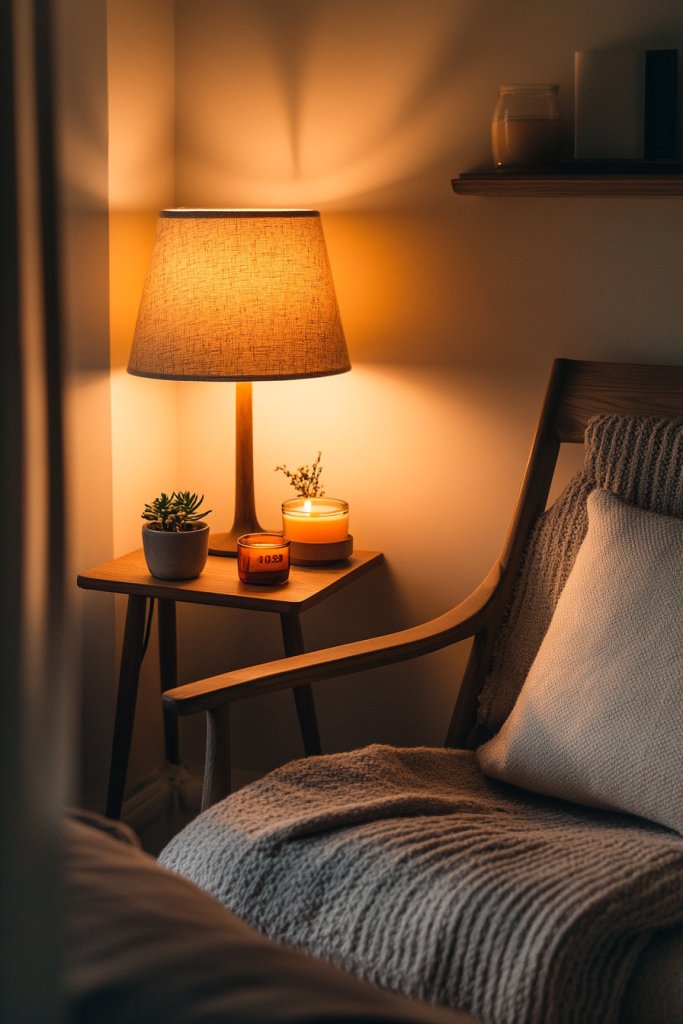
Teenagers often struggle to wind down after a busy day, leading to restless nights and poor sleep. A dedicated nighttime routine nook helps create a calming environment for winding down. It signals to your brain that it’s time to relax, making sleep easier and more restorative. It’s about turning your room into a sanctuary of serenity.
Envision a cozy corner with soft, textured cushions, gentle lighting, and calming colors like pale blue or muted lavender. A small table or shelf holds your favorite skincare, a journal, or a calming diffuser (avoiding wall art). Warm, dimmable lighting—like fairy lights or a small table lamp with a soft shade—creates a peaceful ambiance. The space feels intimate, quiet, and inviting, perfect for unwinding.
Use plush cushions or a small floor pillow for comfort. Incorporate textured fabrics like velvet or fleece for tactile warmth. Seasonal updates could include cozy throws or scented sachets. Keep the area free from electronic devices—no screens or chargers—to support a tech-free zone. Adjust lighting and decor to reflect your mood or the time of year.
Select a corner or small space that can be dedicated to relaxation. Use soft cushions, textured throws, and warm lighting to set the mood. Keep skincare or relaxation tools within reach but organized—small baskets or trays work well. Incorporate calming scents with candles or diffusers (avoiding flame if safety is a concern). Establish a nightly routine that includes reading, journaling, or meditation, reinforcing the peaceful vibe.
Add personal touches with favorite scents, calming music, or a handmade journal. Incorporate seasonal decor—like a cozy blanket or a soft plush toy. Use decorative elements like textured wall panels or fabric banners to deepen the calming effect. Keep the space simple and clutter-free, making it a true retreat.
A dedicated nighttime nook helps establish healthy sleep habits and reduces stress. It promotes self-care and mindfulness, essential for growth and confidence. When your space signals calm, you’ll look forward to unwinding and facing each day refreshed. Remember, creating space for rest is a vital part of your personal journey.
19. Personalize with DIY Decor Projects to Foster Creativity and Ownership
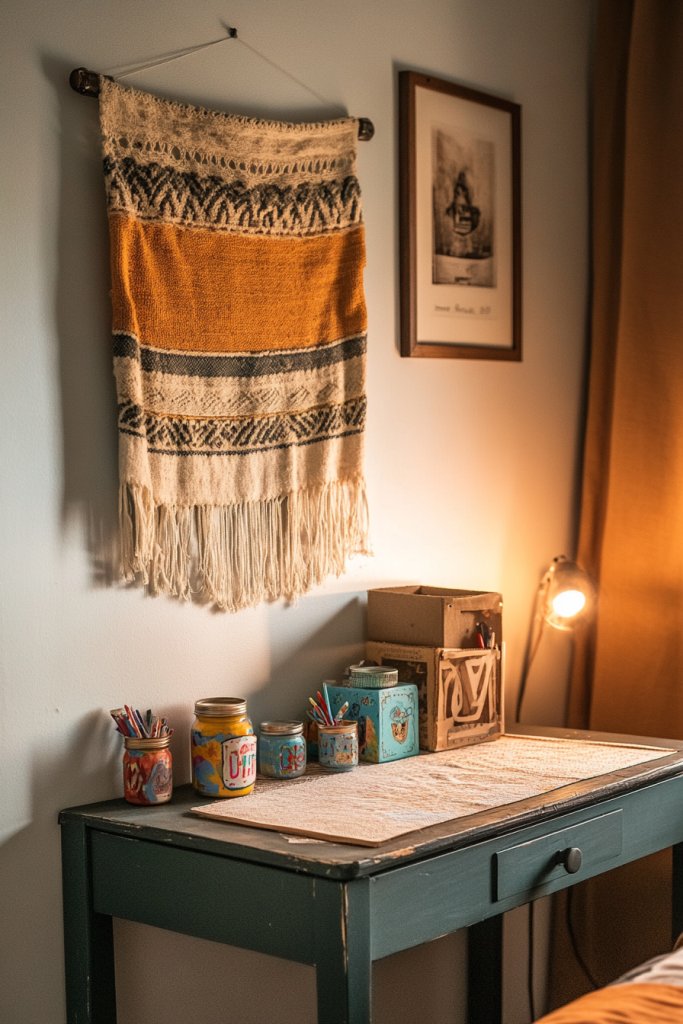
Teenagers often feel disconnected from their space, especially if everything looks store-bought or generic. DIY decor projects let you put your personal stamp on your room, making it feel truly yours. They foster creativity and ownership, boosting confidence and pride. Plus, they’re fun and affordable!
Imagine hanging handmade wall hangings crafted from macrame or painted with your favorite patterns. Customized photo frames, painted flower pots, or decorated storage boxes add character. Use simple materials like fabric, paint, or string to create unique pieces that reflect your personality. The room becomes a canvas of your creativity, full of personal stories and style.
Choose projects that match your skill level and style—simple painted signs, stitched textiles, or upcycled furniture. Seasonal or mood-based themes can inspire new projects—think personalized holiday decor or motivational banners. Incorporate recycled or thrifted items to keep it eco-friendly and budget-friendly. Mix DIY elements with store-bought pieces for a balanced look.
Start with a project idea—like a painted corkboard or a custom wall art piece. Gather supplies—paint, fabric, glue, or craft tools—and set aside time. Get creative with colors, patterns, and textures, ensuring they align with your room’s theme. Secure your DIY decor properly, and display it prominently. Regularly update or add new projects to keep your space fresh and meaningful.
Personalize projects with your initials, favorite quotes, or symbols. Use mixed media—like combining paint with fabric or paper—to add depth. Incorporate meaningful objects, like souvenirs or handmade charms, into your decor. Showcase your creations in visible areas to boost pride and ownership.
DIY decor fosters a sense of achievement and uniqueness. It reminds you that your space is a reflection of your personality and effort. Engaging in creative projects builds skills and confidence that extend beyond your room. Every handmade piece is a testament to your growth and individuality.
20. Incorporate a Reward System with Visual Progress Charts and Achievement Trackers
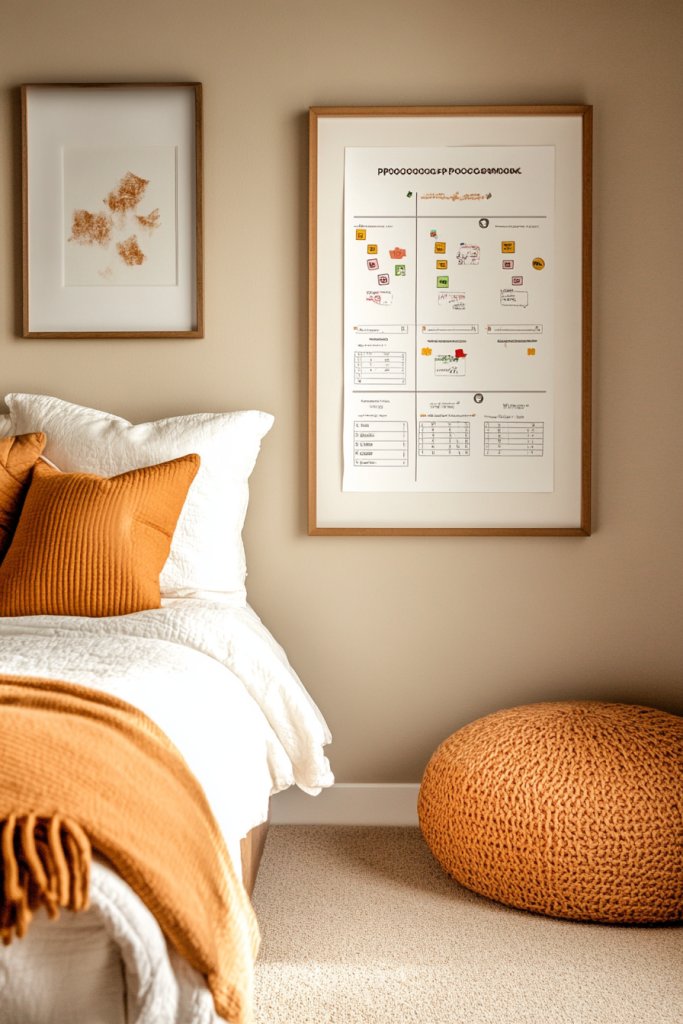
Teenagers often struggle with motivation, especially when working towards goals like grades, chores, or personal projects. A reward system makes progress visible and tangible, encouraging consistent effort. Visual progress charts and achievement trackers turn abstract goals into motivating milestones. It’s about making success fun and rewarding.
Imagine a colorful chart or poster with stickers, stamps, or markers that show your progress. As you complete tasks—like finishing homework or chores—you add stickers or checkmarks. The chart could include sections for short-term goals and long-term dreams, visually connecting effort with achievement. Placed on a wall or door, it becomes a daily reminder of what you’re working toward.
Choose a theme that matches your room’s style—minimalist, playful, or motivational. Use magnets, stickers, or removable decals to make updating easy. Incorporate different colors or shapes for various types of goals—academic, personal, or hobbies. You can also add small reward tokens or notes for extra motivation, avoiding wall art.
Create or buy a large progress chart suitable for your space. Dedicate a section for goals, tasks, or habits. Use stickers, stamps, or checkmarks to mark accomplishments. Update the chart regularly—daily or weekly—and celebrate milestones. Use motivational quotes or affirmations nearby to reinforce positive effort. Keep supplies like stickers or markers accessible.
Personalize with your favorite colors, themes, or symbols. Incorporate small rewards—like a special treat or activity—linked to achieving milestones. Use a combination of visual and tactile rewards to keep motivation high. Allow room for reflection or notes to celebrate what you’ve learned or improved.
A reward system visualizes your progress, making growth tangible and achievable. It boosts confidence by showing you how far you’ve come and encouraging continued effort. Over time, this habit builds discipline and a growth mindset. Remember, every small success is a step toward your bigger dreams.
Conclusion
With a variety of design ideas—from vibrant accents to calming themes and functional layouts—this collection offers inspiration for every teen’s unique style and personality. Feel empowered to try these creative concepts and tailor them to your own space, making it truly yours. Remember, a well-designed bedroom can be a powerful tool for confidence and self-discovery—so start transforming your space today and create a haven where growth and inspiration flourish!
Leave a Reply